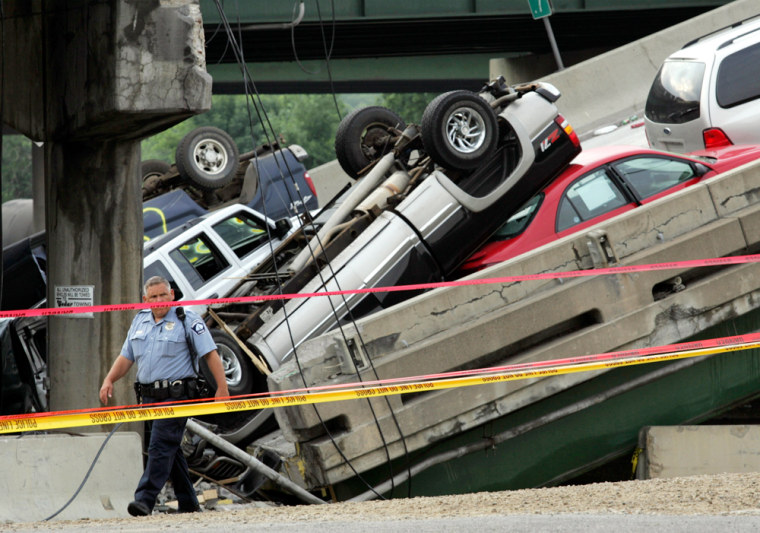A plan to replace the bridge that collapsed into the Mississippi River last week is on the fastest of fast tracks: State officials want the span open by the end of next year, and contractors interested in the job must contact the state by dawn Wednesday.
State officials have an ambitious schedule to award contracts to replace the bridge next month, even as search crews remained stymied in their efforts to recover at least eight missing victims from the depths of the Mississippi River. Five people are confirmed dead.
A brutal winter could throw the state’s rapid reconstruction schedule off. But other conditions are favorable — including a construction industry with plenty of available resources to take on such a daunting challenge.
“It is doable. It is a bit fast, but this is an emergency,” said Khaled Mahmoud with the Bridge Engineering Association in New York. “And if we are ever good at anything, it’s responding to emergencies.”
It took only seconds Wednesday night for the eight-lane, 1,900-foot steel truss Interstate 35W bridge, which opened in 1967, to collapse. Three days later, the state had already begun looking for companies interested in erecting a new bridge in just 16 months.
Normally a three-year project
Erecting a new bridge like Minneapolis’ would ordinarily take about three years, even if the design and building phases were overlapped to save time, said Bill Cox, owner of Corman Construction Inc. in Annapolis Junction, Md., a road and bridge construction firm.
Teams of designers and builders are racing to meet the first hurdle, showing they are qualified to bid, said Dick Stehly of American Engineering Testing of St. Paul, which is seeking a role in soil engineering and quality control.
“This is going to be state-of-the-art type of building, which is rapid but also very, very safe and sound,” he said.
The goal of awarding contracts in mid-September is highly ambitious given the array of questions to be answered, including whether to mimic the former bridge’s alignment, how much traffic to accommodate, how much to spend and what it will look like.
“We have committed ourselves to getting it done quickly, but we have also committed ourselves to not getting it done in a way that it is obsolete the day it opens,” Minneapolis Mayor R.T. Rybak said.
As suppliers are being asked to free up steel, rebar and other key components, state transportation officials warn other projects may languish if a new bridge is to be standing by the end of 2008.
“With an accelerated construction project, you’re going to pay for the acceleration,” said Jon Chiglo, bridge reconstruction project manager for the state Department of Transportation. “There’s definitely impacts to the rest of the system in the area. It’s important to us to get the bridge back in service.”
Bush signs legislation
The new bridge’s design will largely determine the cost, and although the federal government has pledged $250 million, Mahmoud said $300 million to $350 million “sounds about right.”
President Bush on Monday signed legislation that directs $250 million to rebuild the bridge. The legislation, passed by Congress over the weekend, waives the $100 million federal limit per state for emergency relief funds, authorizing $250 million for rebuilding the bridge.
The money itself still needs to be appropriated by Congress in future legislation.
Federal money for emergency reconstruction of the bridge is primarily meant for replacement of what was lost, along with some reasonable accommodation for increased traffic, said Bob McFarlin, spokesman for Minnesota’s transportation department.
So if the state wants to include some upgrades — like another exit for downtown, better access to the University of Minnesota campus, and features that would make it a landmark showpiece — it may have to pay for them itself.
Brutal weather to pose a challenge
Minnesota’s brutal winter weather will unquestionably pose a challenge to fast-track bridge building, said Dave Semerad, spokesman for the Associated General Contractors of Minnesota in St. Paul.
“There will be barges required for this construction, and a lot depends on the temperature,” he said. “If the river freezes, then you’re not going to be able to have barges moving around.”
The state intends to write financial incentives into the contract to make the compressed schedule more likely to be met.
Similar incentives helped traffic began moving in December on one of the parallel three-mile Interstate 10 bridges over Escambia Bay in Pensacola, Fla. The $242 million project is replacing bridges damaged by 2004’s Hurricane Ivan.
Divers continue recovery operation
At the disaster site Monday, weary dive teams were getting reinforcements to help in the slow search: Navy divers had arrived and FBI dive teams were on the way with powerful technology, including a robotic submarine. Heavy equipment also was moving into place to begin removing the tons of debris lying across the Mississippi.
Hennepin County Sheriff Rich Stanek said that divers had done about all they could and that clearing out the tangle of twisted steel and broken concrete may be the only way to find any of the missing.
John L. Sanders, director of the Ohio-based National Underwater Rescue Recovery Institute, said it’s not surprising that the missing haven’t been found yet. Some may have been able to partially escape their vehicles, then been swept downstream. They could be trapped in tangles of rebar or pinned in vehicles by seat belts and air bags, or by debris, he said.
Also Monday, an attorney for the company that had been resurfacing the bridge declined to comment on a report that some workers said they had felt the bridge wobbling unusually in the days before the collapse. The NTSB has said the report will be part of its investigation.
Progressive Contractors Inc. “continues to believe that its work did not cause the collapse,” attorney David Lillehaug said in an e-mail.
